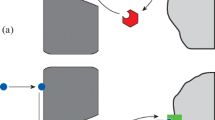Summary
The vertebrate and arthropod integument structures are characterized by pyroelectric behaviour and a permanent electric polarization (=permanent electric moment) along two principal axes. These two directions of polarization constitute a uniform feature of the integument structures in situ and remain unchanged during ontogenesis. The species were selected so as to be representative of the entire line of vertebrates (including man) and arthropods.
The longitudinal polarization follows the longitudinal fibril alignment. In hair, bristles, claws, horns, bills, feather shafts and in the antennae of arthropods, the positive pole of the permanent electric moment was invariably oriented towards the distal end. The outside-inside polarization is at right angles to the external surfaces of all the integument structures. It was possible to investigate the keratinized appendages of vertebrate skin as well as the cuticle of most arthropods in the fresh state, whereas the corium and the epidermis of vertebrate skin had to be air-dried before examination.
In all the integument structures investigated, an experimental change of temperature or of light intensity, as well as the action of mechanical stress, resulted in a pyroelectric (or piezoelectric) signal. On the basis of these findings the possibility is discussed that there may be a common mechanism of action responsible for the development of the receptor potential (generator potential) in thermoreceptors, photoreceptors and mechanoreceptors.
Zusammenfassung
Die Keratin- und Kollagenstrukturen des Vertebraten-Integuments, sowie die Chitinstrukturen des Arthropoden-Integuments zeigen pyro- und piezoelektrisches Verhalten und eine permanente elektrische Polarisation (=permanentes elektrisches Moment) in zwei meßtechnisch klar unterscheidbaren Polarisationsrichtungen (Längspolarisation und Außen/Innen-Polarisation). Beide Polarisationsrichtungen liegen in situ fest und bleiben während der Ontogenese unverändert bestehen. Die untersuchten Species wurden so ausgewählt, daß sie einen repräsentativen Querschnitt durch die Vertebratenreihe (einschließlich des Menschen) und die Arthropodenreihe darstellen.
Die Längspolarisation verläuft in Fibrillen-Längsrichtung und ist makroskopisch meßbar in Strukturen mit leidlicher Parallelausrichtung ihrer Fibrillenbündel. Bei Haaren, Borsten, Krallen, Hörnern und Schnäbeln, bei Federschäften und Insektenantennen lag der positive Pol des elektrischen Momentes übereinstimmend in Richtung zum distalen Ende. Die Außen/ Innen-Polarisation besteht senkrecht zur Außenfläche in sämtlichen untersuchten Integument-Strukturen. Die Keratinanhänge des Vertebraten-Integuments und die Cuticula der meisten Arthropoden konnten in frischem Zustande, unmittelbar nach Tötung der Tiere, untersucht werden, während Corium und Epidermis der Vertebratenhaut nur in lufttrockenem Zustande gemessen werden konnten.
In sämtlichen untersuchten Integument-Strukturen entstand bei einer experimentellen Veränderung der Temperatur oder der Lichtintensität, aber auch bei einseitiger mechanischer Beanspruchung ein pyroelektrisches (bzw. piezoelektrisches) Signal. Aufgrund dieser Befunde wird die Möglichkeit diskutiert, daß bei der Entstehung des Receptorpotentials (Generator-potentials) in den Thermoreceptoren, Photoreceptoren und Mechanoreceptoren ein gemeinsamer Wirkungsmechanismus besteht.
Similar content being viewed by others
References
Athenstaedt, H.: Permanent electric polarization of the meninges of man. Z. Zellforsch. 98, 300–322 (1969).
Athenstaedt, H.: Permanent electric polarization and pyroelectric behaviour of the vertebrate skeleton. V. The appendicular skeleton of the vertebrates (excluding man). Z. Anat. Entwickl.-Gesch. 131, 1–20 (1970a).
Athenstaedt, H.: Permanent electric polarization and pyroelectric behaviour of the vertebrate skeleton. VI. The appendicular skeleton of man. Z. Anat. Entwickl.-Gesch. 131, 21–30 (1970b).
Athenstaedt, H.: Permanent longitudinal electric polarization and pyroelectric behaviour of collagenous structures and nervous tissue in man and other vertebrates. Nature (Lond.) 228, 830–834 (1970c).
Athenstaedt, H.: Pyroelectric and piezoelectric behaviour of human dental hard tissues. Arch. oral Biol. 16, 495–501 (1971).
Beament, J. W. L.: Electrical properties of oriented lipid on a biological membrane. An electrostatic diffusion barrier and ion pump. Nature (Lond.) 191, 217–221 (1961).
Beament, J. W. L.: Active transport of water in insects. Adv. Insect. Physiol. 2, 67–129 (1964).
Chynoweth, A. G.: Dynamic method for measuring the pyroelectric effect with special reference to barium titanate. J. appl. Phys. 27, 78–84 (1956).
Crewther, W. G., Fraser, R. D. B., Lennox, F. G., Lindley, H.: The chemistry of keratins. Advanc. Protein Chem. 20, 191–346 (1965).
Hodge, A. J., Schmitt, F. O.: The charge profile of the tropocollagen macromolecule and the packing arrangement in native-type collagen fibrils. Proc. nat. Acad. Sci. (Wash.) 46, 186–197 (1960).
Lang, S. B., Steckel, F.: Method for the measurement of the pyroelectric coefficient, d. c. dielectric constant, and volume resistivity of a polar material. Rev. Sci. Instrum. 36, 929–932 (1965).
Martin, A. J. P.: Tribo-electricity in wool and hair. Proc. phys. Soc. (Lond.) 53, 186–189 (1941).
Author information
Authors and Affiliations
Rights and permissions
About this article
Cite this article
Athenstaedt, H. Pyroelectric behaviour of integument structures and of thermo-, photo- and mechanoreceptors. Z. Anat. Entwickl. Gesch. 136, 249–271 (1972). https://doi.org/10.1007/BF00522615
Received:
Issue Date:
DOI: https://doi.org/10.1007/BF00522615




